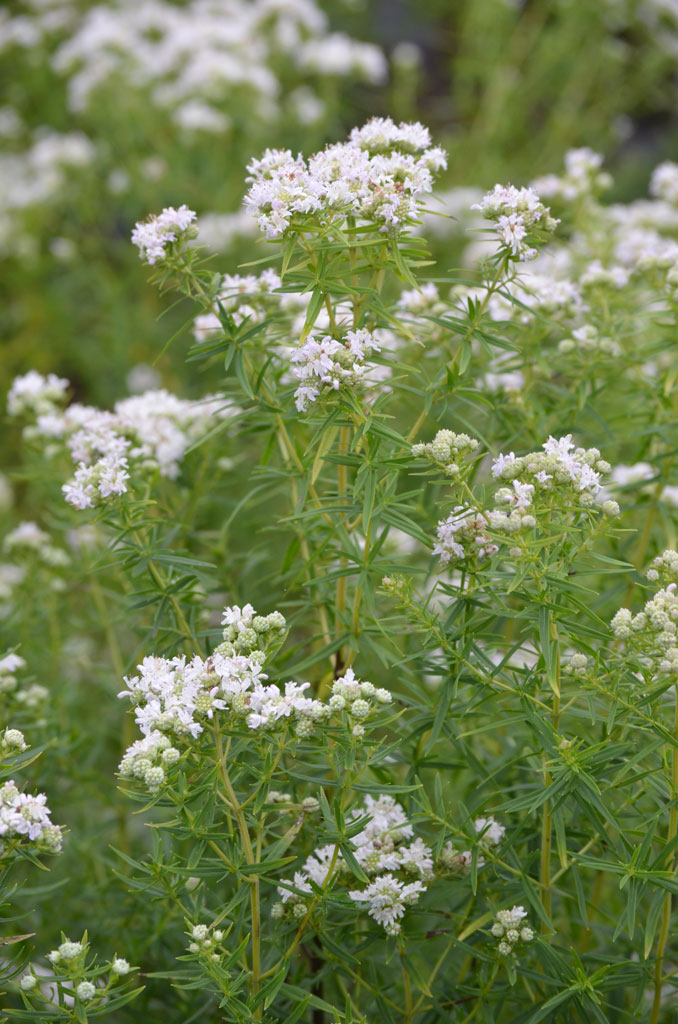

Handles drought like a champ and tolerates harsh, sunny exposures. Tolerates almost any soil, except for those with poor drainage. While considered a spreading species, it certainly does not tend to spread too far or become aggressive. Virginia mountain mint tends to grow 2 to 3 feet tall and spreads up to 2 feet. Its leaves can be used in herbal teas or dried for savory dishes (similar to oregano). This species is highly aromatic, you can smell its minty scent when you brush past it. We love the fine foliage of the Virginia Mountain Mint, and its spicy-minty aroma! One of the showier “bloomers”, it sports white flowers that rise above lower plants, creating a ‘mist’ of white - an enchanting effect in the moonlight. This easy-care, deer resistant perennial is a must-have for any pollinator garden. Continue reading to learn more about each species, and how you can utilize them in your gardens and landscapes. flexuosum has large individual flowers in loose clusters, appearing almost prickly. incanum have small, sparse blooms that are set within large, showy, silver bracts (modified leaves) which help draw pollinating insects. tenuifolium have showy, tight clusters of white flowers atop of their fine foliage. Flowers are almost always white or creamy in color, but their arrangements on each species varies from the next. muticum some species also sport a silvery-colored foliage, such as P. tenuifolium, to the large, broad foliage of P.

Foliage textures range from fine, needle-like leaves, such as with P. The flowers and foliage, species to species, vary considerably. The spreading species are excellent plants to use as taller groundcovers, while clumping species are easily tucked between other perennials!

muticum, which requires more space for the rhizomes to spread. incanum, are generally considered “well-behaved” compared to the spreading species, such as P. Some are clumpers and others are spreaders. All are robust, upright plants, though their habits may differ in the garden. Preferred soils for mountain mints include average to moist, well-drained, fertile soils though most will perform just fine in dry soils or even in clay soils as long as water doesn’t pool there.
#Mountain mint full
A Look at Different Mountain MintsĪll of the mountain mints generally prefer full sun to part shade, and most are very adaptable. Historically, mountain mint flowers were used to treat tooth aches. If they do, they are done after a nip or two when they realize its not their “cup of tea”! While they are not as pungent as the true mints, such as culinary peppermint or spearmint, mountain mints are certainly useful for herbal teas, tinctures, and salves. Deer, rabbits, groundhogs, or voles rarely browse mountain mints. All mountain mints, like true mints, are deer resistant due to their aromatic nature. We grow 5 species here at Edge of the Woods. There are several species of mountain mints native to Eastern North America, with about 8 species occurring across Pennsylvania. In bloom for about 8 weeks in the summer, these mints provide endless entertainment for the watchful gardener and enough nectar for all who alight. It is such a fun plant to observe, and watch all of its faunal associations unfold before your eyes. They also attract important predatory and parasitoid insects that prey upon pest insects. A spectacular variety of butterflies, bees, wasps, moths, and other beneficial insects cover the blossoms from sun up to sun down.

#Mountain mint Patch
All day long, when in bloom, a patch of mountain mint literally “buzzes” with the sound of active pollinators. They are some of the absolute best plants for attracting and supporting pollinators in your garden. Mountain mints are botanically classed as Pycnanthemum species.
#Mountain mint series
One in a series highlighting our favorite pollinator plants:


 0 kommentar(er)
0 kommentar(er)
